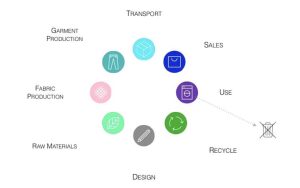
Why Do We Need a Sustainable Makeover in Textile and Fashion Industry
October 14, 2018
ASFW, Addis Abba, Ethopia
November 18, 2019Why the Circular Fashion Supply Chain Starts with Choosing the Right Material: Fiber, Yarn, Fabric?
Did you know that the fashion industry holds the most lengthy and complex manufacturing chains?

Given this fact, there is no wonder that the fashion industry today struggles to shift its supply chains towards the circular economy.
But what exactly is the circular fashion supply chain and which choices do influence your ecological impact the most?

Source : WGSN, 2018
The circular fashion supply chain starts with the Designer choosing the right yarns material: fiber, yarn, and fabric.
Decisions made during the design phase are responsible for 80 to 90% of the environmental and economic costs (Close The Loop, 2017).
What we have experienced so far in the linear economic fashion model (take, make, use and dispose), is that the fashion designers choose their fabrics according to two aspects: the aesthetic and the price.
However, when it comes to circular design, the entire goal and mind-set of the design process is put up-side-down. Circular designers set themselves the goal to create new products in respecting the environment and ethics. They are willing to dig deeper and research about not only their fabrics but also about the right yarn blends, which will determine the life cycle and carbon footprint of the garment. Design equals to change.
Sourcing: The Corporation of Design and Sourcing
Making sure that both parties working towards circular goals, the sourcing department represents an essential part in determining the circular supply chain. Working closely together with the design department, sourcing needs to make sure to find the right balance between expressing the needs of the designer, choosing the right durable mix of yarn blends and finding the right price point.
Distribution: Information about the Product
According to The Business of Fashion, 52% of Millennials are looking for background information
before buying, 45% at Gen Z and 41% of Baby Boomers 45% at Gen Z and 41% of Baby Boomers.
Consumers want to find all the necessary information about their products in their stores, webshops and on social media channels (The Business of Fashion, 2018) Examples of brands who are smart in communicating about transparency are Everlane, Mara Hoffmann, Levi’s, Patagonia and Eileen Fisher.
Use: The Impact of the Customer
The customer of today has to take part in shifting this industry too. By consciously taking care of their garments and washing less, as well as choosing an eco-friendly materials will lower the environmental impact of its garment. Isn’t that great! You have the power to change the world by deciding to take only small steps towards a better future!
To sum it up, the impact of the designer and the sourcing department are the most essential in the circular fashion model. By choosing the right fabric with the right yarn compositions, the ecological footprint of the garment is determined. Furthermore, the customers are more and more conscious about transparency, therefore companies should communicate all the important aspects to the customer right away. And last but not least, the customer is also responsible to choose the right garment and to treat it the way it has to be treated, in washing and caring their beloved clothes.
Looking for Recycled & Regenerated Yarns for your next sustainable fashion project? Contact Usha Yarns today!
References:
https://www.circulardesignguide.com/
https://close-the-loop.be/en/phase/5/design
https://cdn.businessoffashion.com/reports/The_State_of_Fashion_2019_v3.pdf






